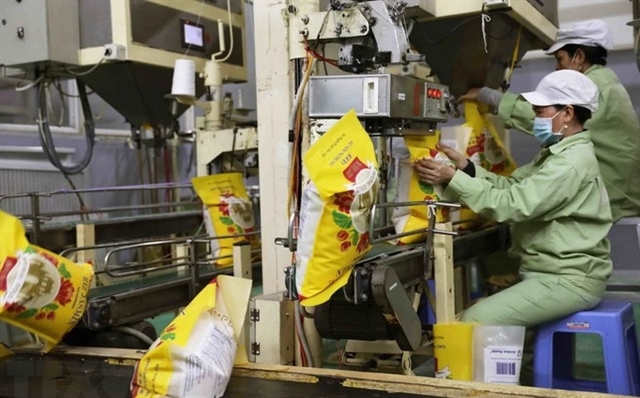HANOI (ANN/VIETNAM NEWS) — Vietnam’s rice exports is expected to exceed 8 million tonnes, entering its second consecutive year, bringing in about USD5 billion.
While the global rice supply is decreasing, and countries such as the Philippines, Indonesia, China and some other markets are all increasing rice imports to ensure food security, it creates opportunities for Vietnamese rice export this year.
After many fluctuations in supply and price last year, global rice trade continues to be “hot” from the beginning of this year.
Limited supply due to unfavourable weather, exports being banned or restricted in some countries, increased import demand in many markets, and Red Sea tensions are the main reasons why the rice market heats up this year.
Global ending inventories for the 2023-2024 crop year is forecasted at more than 167 million tonnes, down 8.6 million tonnes compared to the previous crop year and the lowest inventory in the past six crop years.
India, the largest exporting country, with more than 20 million tonnes of rice per year, has applied policies restricting rice exports since the middle of last year.
Many countries have turned to finding alternative sources of rice supply, especially from Southeast Asia, creating opportunities for Vietnamese rice to increase exports, as well as get good export prices.
Vietnam’s rice exports earned more than USD4 billion last year, with earnings expected to rise even more this year.
Nguyễn Anh Sơn, director of the Import-Export Department, Ministry of Industry and Trade (MoIT), analysed that Vietnam’s rice industry has had remarkable growth through strong transformation in both production and export. The growth in output, product quality and improved production processes have helped expand the market and enhance the position of Vietnamese rice in the international market.
Selective markets such as Europe, the US, South Korea and some new markets in the Middle East tend to favour high-quality Vietnamese rice.
The MoIT requests localities and rice industry business associations to share information and propose solutions in market development, with close co-ordination between units under the ministry and Vietnamese trade offices abroad in building and implementing practical, effective trade promotion activities to support rice industry enterprises in exploiting diverse export markets, building and enhancing the Vietnamese rice brand.
The Philippines can import up to 4.1 million tonnes of rice this year, up from the previous forecast of 3.9 million tonnes. Its rice imports soared due to the drought affecting domestic rice output.
China was Vietnam’s third largest rice import partner last year, with output of 917,255 tonnes, turnover of more than USD530 million, with an average price of USD578 per tonne.
It is predicted that this year, this market will increase rice imports to balance import and production to ensure food security, possibly exceeding the figure of more than 900,000 tonnes last year, while export price also has room for further increases.
The Voice of Việt Nam (VOV) online newspaper quoted Nguyễn Ngọc Nam, Chairman of the Việt Nam Food Association, as saying that the association recommended that the MoIT strengthened information on import and export data this year, to balance rice supply and demand of the parties favourably.
He also recommended conducting market research to conduct trade promotion programmes in markets, to promptly update information about rice exporters to best orient exports.
Also vital are efforts to research and negotiate to sign preferential trade agreements with a number of potential markets to take advantage of the progress of the agreements that have been put into effect and request partners to open up more, increasing Vietnam’s rice quota.
Finally, there is the work of raising awareness of traders implementing free trade regulations to ensure sustainable production and export in Vietnam.
With timely support policies from the Government, ministries and branches, and solutions to open the market, circulate goods and promote production, the export of rice has recorded a number of positive results, contributing to the consumption of rice and commodity rice at prices favourable to farmers.
Rice prices in Indonesia soared early this year due to a serious supply shortage.
Indonesia has experienced eight consecutive months of rice supply shortage compared to demand as of February this year, with rice scarcity in supermarkets, while in the Philippines the Department of Trade and Industry (DTI) has asked people to switch to buying rice with stabilisation prices to avoid rice prices rising too high in the free market.
Despite being one of the primary supply sources for Senegal, a country with one of the highest per capita rice consumption rates in West Africa, Vietnam’s rice exports to the nation remain modest.
According to the Việt Nam Trade Office in Algeria and Senegal, Việt Nam shipped 12,000 tonnes of rice to Senegal last year, resulting in a turnover of USD5.35 million, up 215 per cent year-on-year. However, the amount is small compared to the African country’s purchase of 1.3 million tonnes of rice in that year.
Senegal imports between 900,000 and 1 million tonnes of the grain annually, mostly low-priced 100 per cent broken rice. Its main suppliers include India, Thailand, China, Pakistan, Uruguay and Vietnam. Apart from serving the domestic market of over 18 million people, the country also imports rice for re-export to neighbouring Mauritania, Guinea-Bissau and Gambia.
In the context of scarce supply and Senegal gearing up for presidential elections this year, it is likely that the nation will increase imports of broken rice from Asia.
In the first two months this year, rice exports reached 920,000 tonnes, worth USD640 million, up 2.1 per cent in volume and 35.2 per cent in value compared to the same period last year, a positive sign in the context of global rice supply being tightened.
Vietnamese rice is currently present in more than 180 countries and territories, including demanding markets such as Europe, the US, South Korea and Australia.



